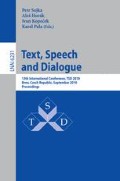Abstract
The ANR EmotiRob project aims at detecting emotions in an original application context: realizing an emotional companion robot for weakened children. This paper presents a system which aims at characterizing emotions by only considering the linguistic content of utterances. It is based on the assumption of compositionality: simple lexical words have an intrinsic emotional value, while verbal and adjectival predicates act as a function on the emotional values of their arguments. The paper describes the semantic component of the system, the algorithm of compositional computation of the emotion value and the lexical emotional norm used by this algorithm. A quantitative and qualitative analysis of the differences between system outputs and expert annotations is given, which shows satisfactory results, with the right detection of emotional valency in 90% of the test utterances.
Access this chapter
Tax calculation will be finalised at checkout
Purchases are for personal use only
Preview
Unable to display preview. Download preview PDF.
References
Ekman, P.: Patterns of Emotions: New Analysis of Anxiety and Emotion. Plenum Press, New York (1999)
Cowie, R., Cornelius, R.: Describing the Emotional States that Are Expressed in Speech. Speech Communication 40, 5–32 (2003)
Schuler, B., et al.: The Relevance of Feature Type for the Automatic Classification of Emotional User States. In: Interspeech 2007, Anvers, Belgique, pp. 2253–2256 (2007)
Seneff, S., Polifroni, J.: A New Restaurant Guide Conversational System: Issues in Rapid Prototyping for Specialized Domains. In: International Conference on Spoken Language Processing (ICSLP 1996), Philadelphia, pp. 665–668 (1996)
Glass, J.: Challenges for Spoken Dialogue Systems. In: Proceedings IEEE ASRU. Workshop, Keystone, Colorado, USA (1999)
Zue, V., Seneff, S., Glass, J., Polifroni, J., Pao, C., Hazen, T., Hetherington, L.: Jupiter: Telephone-Based Conversational Interface for Weather Information. IEEE Transactions on Speech and Audio Processing XX(Y), 100–112 (2000)
Villaneau, J. and Antoine, J-Y.: Deeper Spoken Language Understanding for Man-Machine Dialogue on Broader Application Domains: A Logical Alternative to Concept Spotting. In: Proceedings of SRSL 2009, the 2nd Workshop on Semantic Representation of Spoken Language, Athens, Greece, pp. 50–57 (2009)
Bassano, D., et al.: Le DLPF, un nouvel outil pour l’évaluation du dévelopement du language de production en français. Enfance 2(5), 171–208 (2005)
Abney, S.: Parsing by Chunks. In: Berwick, R., Abney, S., Tenny, C. (eds.) Principle Based Parsing. Kluwer Academic Publishers, Dordrecht (1991)
El Maarouf, I.: Natural Ontologies at Work: Investigating Fairy Tales. In: Corpus Linguistics 2009, Liverpool, G.B. (2009)
Niedenthal, P.M., Auxiette, C., Nugier, A., et al.: A Prototype Analysis of the French Category “émotion”. Cognition and Emotion 18, 289–312 (2004)
Zammuner, V.L.: Concepts of emotion: Emotioness and Dimensional Rating of Italian Emotion Words. Cognition and emotion 12(2), 243–272 (1998)
Vasa, R.A., Carlino, A.R., London, K., Min, C.: Valence Ratings of Emotional and Non-Emotional Words in Children. Personality and Individual Differences 41, 1169–1180 (2006)
Syssau, A., Monnier, C.: Children’s Emotional Norms for Six Hundred French Words. Behavior, Research, and Methods 41, 213–219 (2009)
Author information
Authors and Affiliations
Editor information
Editors and Affiliations
Rights and permissions
Copyright information
© 2010 Springer-Verlag Berlin Heidelberg
About this paper
Cite this paper
Le Tallec, M., Villaneau, J., Antoine, JY., Savary, A., Syssau, A. (2010). Emologus—A Compositional Model of Emotion Detection Based on the Propositional Content of Spoken Utterances. In: Sojka, P., Horák, A., Kopeček, I., Pala, K. (eds) Text, Speech and Dialogue. TSD 2010. Lecture Notes in Computer Science(), vol 6231. Springer, Berlin, Heidelberg. https://doi.org/10.1007/978-3-642-15760-8_46
Download citation
DOI: https://doi.org/10.1007/978-3-642-15760-8_46
Publisher Name: Springer, Berlin, Heidelberg
Print ISBN: 978-3-642-15759-2
Online ISBN: 978-3-642-15760-8
eBook Packages: Computer ScienceComputer Science (R0)

